Essential Theories For Human Language Emergence
VerifiedAdded on 2022/08/12
|10
|2476
|30
AI Summary
Contribute Materials
Your contribution can guide someone’s learning journey. Share your
documents today.
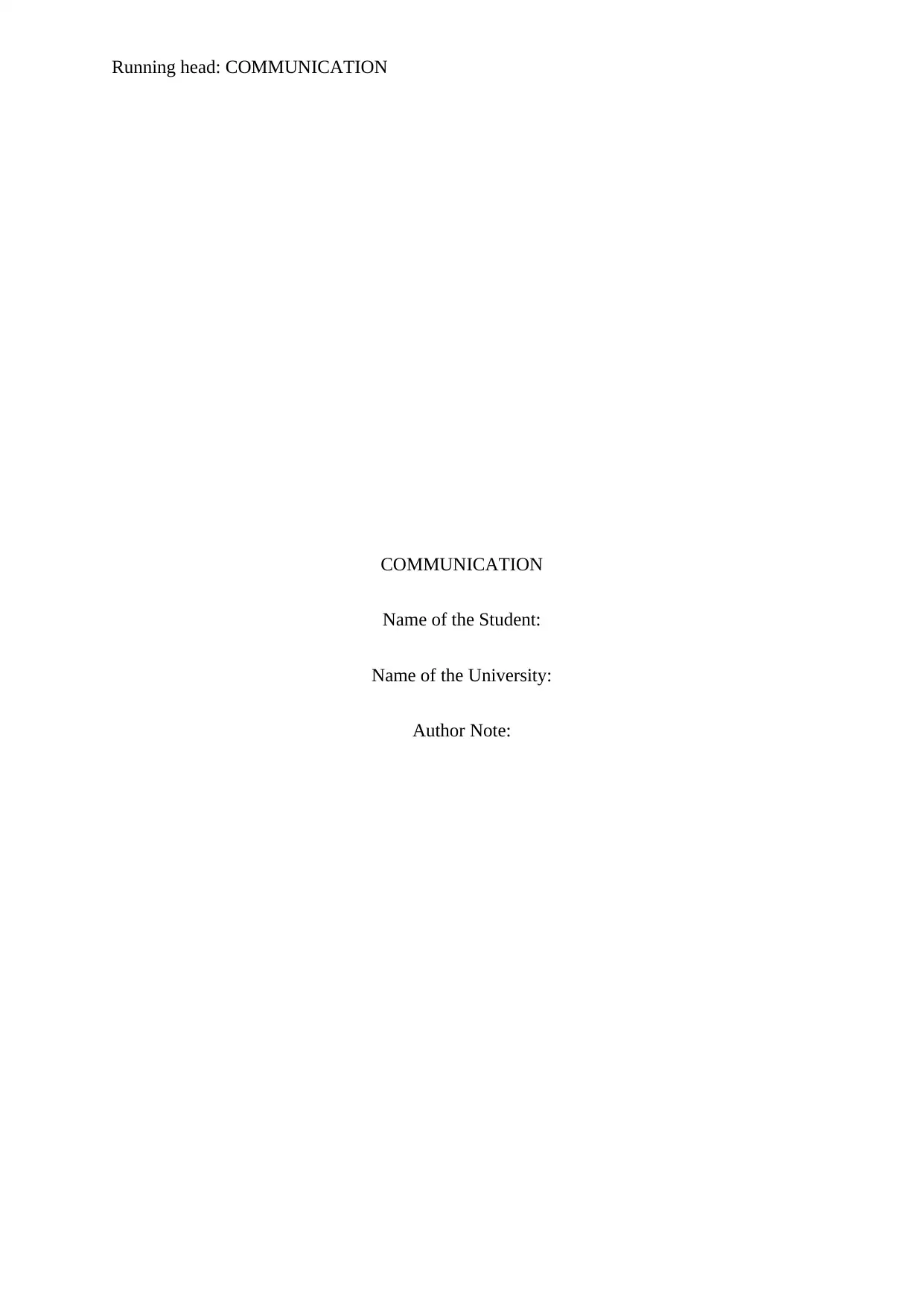
Running head: COMMUNICATION
COMMUNICATION
Name of the Student:
Name of the University:
Author Note:
COMMUNICATION
Name of the Student:
Name of the University:
Author Note:
Secure Best Marks with AI Grader
Need help grading? Try our AI Grader for instant feedback on your assignments.
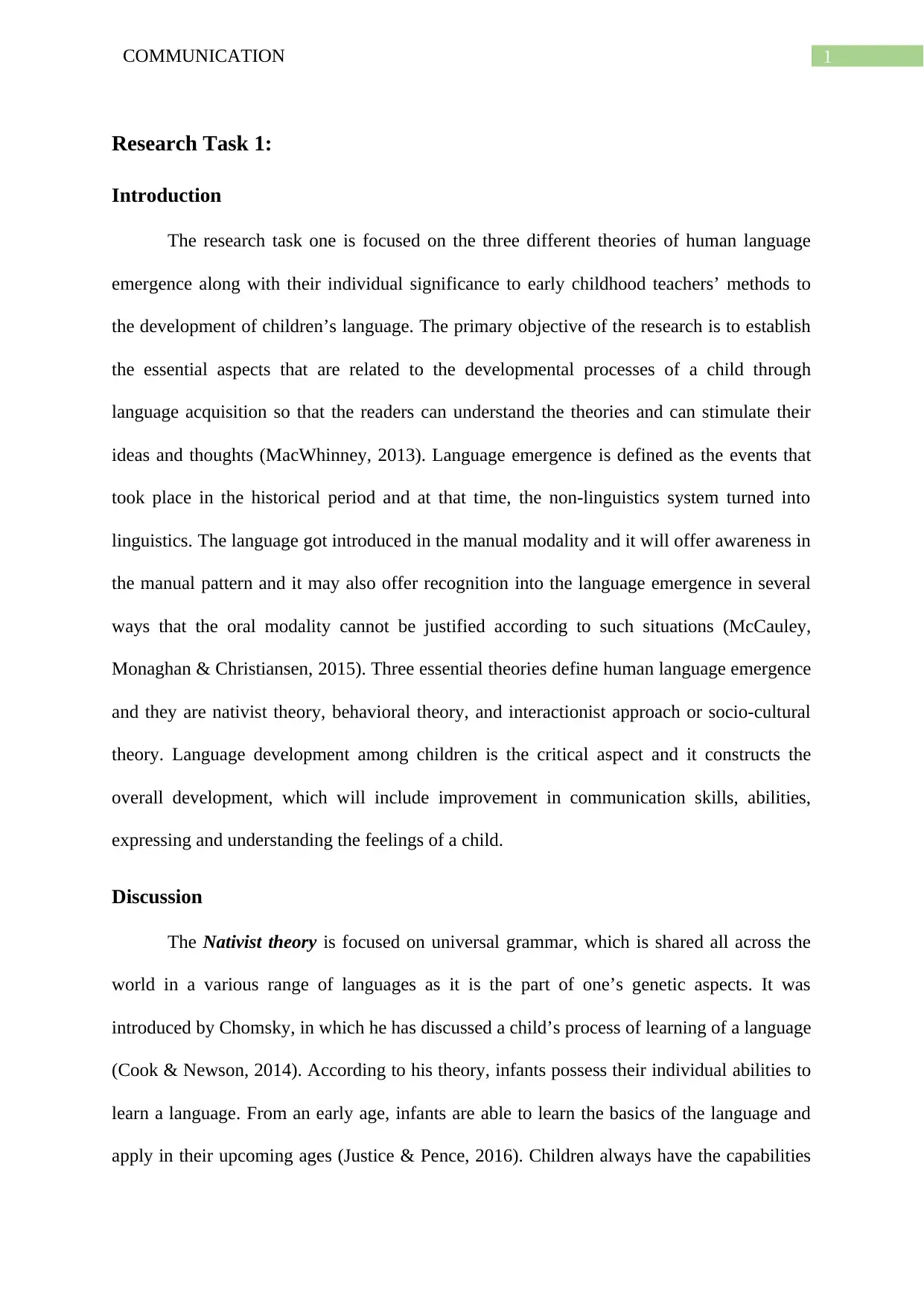
1COMMUNICATION
Research Task 1:
Introduction
The research task one is focused on the three different theories of human language
emergence along with their individual significance to early childhood teachers’ methods to
the development of children’s language. The primary objective of the research is to establish
the essential aspects that are related to the developmental processes of a child through
language acquisition so that the readers can understand the theories and can stimulate their
ideas and thoughts (MacWhinney, 2013). Language emergence is defined as the events that
took place in the historical period and at that time, the non-linguistics system turned into
linguistics. The language got introduced in the manual modality and it will offer awareness in
the manual pattern and it may also offer recognition into the language emergence in several
ways that the oral modality cannot be justified according to such situations (McCauley,
Monaghan & Christiansen, 2015). Three essential theories define human language emergence
and they are nativist theory, behavioral theory, and interactionist approach or socio-cultural
theory. Language development among children is the critical aspect and it constructs the
overall development, which will include improvement in communication skills, abilities,
expressing and understanding the feelings of a child.
Discussion
The Nativist theory is focused on universal grammar, which is shared all across the
world in a various range of languages as it is the part of one’s genetic aspects. It was
introduced by Chomsky, in which he has discussed a child’s process of learning of a language
(Cook & Newson, 2014). According to his theory, infants possess their individual abilities to
learn a language. From an early age, infants are able to learn the basics of the language and
apply in their upcoming ages (Justice & Pence, 2016). Children always have the capabilities
Research Task 1:
Introduction
The research task one is focused on the three different theories of human language
emergence along with their individual significance to early childhood teachers’ methods to
the development of children’s language. The primary objective of the research is to establish
the essential aspects that are related to the developmental processes of a child through
language acquisition so that the readers can understand the theories and can stimulate their
ideas and thoughts (MacWhinney, 2013). Language emergence is defined as the events that
took place in the historical period and at that time, the non-linguistics system turned into
linguistics. The language got introduced in the manual modality and it will offer awareness in
the manual pattern and it may also offer recognition into the language emergence in several
ways that the oral modality cannot be justified according to such situations (McCauley,
Monaghan & Christiansen, 2015). Three essential theories define human language emergence
and they are nativist theory, behavioral theory, and interactionist approach or socio-cultural
theory. Language development among children is the critical aspect and it constructs the
overall development, which will include improvement in communication skills, abilities,
expressing and understanding the feelings of a child.
Discussion
The Nativist theory is focused on universal grammar, which is shared all across the
world in a various range of languages as it is the part of one’s genetic aspects. It was
introduced by Chomsky, in which he has discussed a child’s process of learning of a language
(Cook & Newson, 2014). According to his theory, infants possess their individual abilities to
learn a language. From an early age, infants are able to learn the basics of the language and
apply in their upcoming ages (Justice & Pence, 2016). Children always have the capabilities
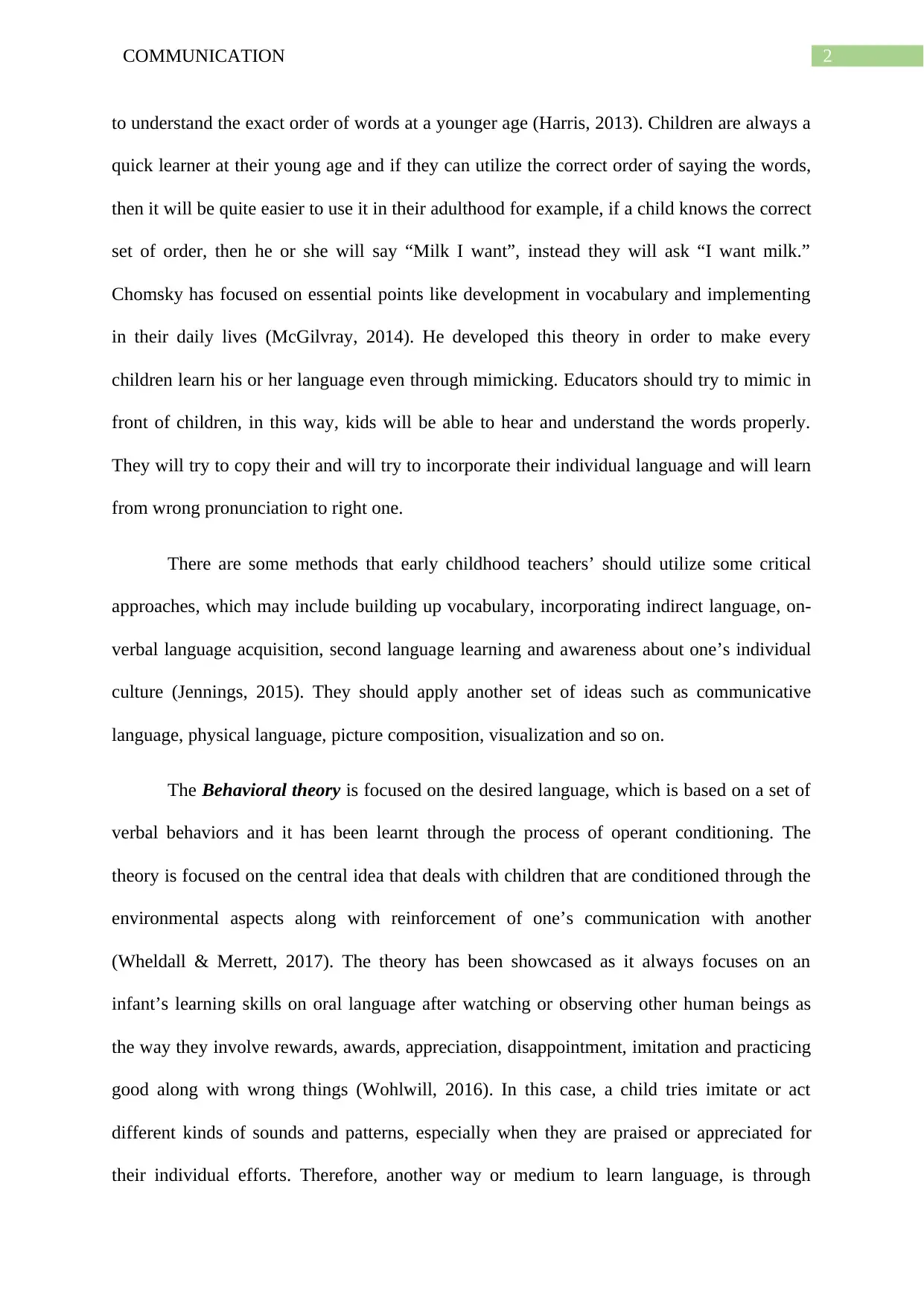
2COMMUNICATION
to understand the exact order of words at a younger age (Harris, 2013). Children are always a
quick learner at their young age and if they can utilize the correct order of saying the words,
then it will be quite easier to use it in their adulthood for example, if a child knows the correct
set of order, then he or she will say “Milk I want”, instead they will ask “I want milk.”
Chomsky has focused on essential points like development in vocabulary and implementing
in their daily lives (McGilvray, 2014). He developed this theory in order to make every
children learn his or her language even through mimicking. Educators should try to mimic in
front of children, in this way, kids will be able to hear and understand the words properly.
They will try to copy their and will try to incorporate their individual language and will learn
from wrong pronunciation to right one.
There are some methods that early childhood teachers’ should utilize some critical
approaches, which may include building up vocabulary, incorporating indirect language, on-
verbal language acquisition, second language learning and awareness about one’s individual
culture (Jennings, 2015). They should apply another set of ideas such as communicative
language, physical language, picture composition, visualization and so on.
The Behavioral theory is focused on the desired language, which is based on a set of
verbal behaviors and it has been learnt through the process of operant conditioning. The
theory is focused on the central idea that deals with children that are conditioned through the
environmental aspects along with reinforcement of one’s communication with another
(Wheldall & Merrett, 2017). The theory has been showcased as it always focuses on an
infant’s learning skills on oral language after watching or observing other human beings as
the way they involve rewards, awards, appreciation, disappointment, imitation and practicing
good along with wrong things (Wohlwill, 2016). In this case, a child tries imitate or act
different kinds of sounds and patterns, especially when they are praised or appreciated for
their individual efforts. Therefore, another way or medium to learn language, is through
to understand the exact order of words at a younger age (Harris, 2013). Children are always a
quick learner at their young age and if they can utilize the correct order of saying the words,
then it will be quite easier to use it in their adulthood for example, if a child knows the correct
set of order, then he or she will say “Milk I want”, instead they will ask “I want milk.”
Chomsky has focused on essential points like development in vocabulary and implementing
in their daily lives (McGilvray, 2014). He developed this theory in order to make every
children learn his or her language even through mimicking. Educators should try to mimic in
front of children, in this way, kids will be able to hear and understand the words properly.
They will try to copy their and will try to incorporate their individual language and will learn
from wrong pronunciation to right one.
There are some methods that early childhood teachers’ should utilize some critical
approaches, which may include building up vocabulary, incorporating indirect language, on-
verbal language acquisition, second language learning and awareness about one’s individual
culture (Jennings, 2015). They should apply another set of ideas such as communicative
language, physical language, picture composition, visualization and so on.
The Behavioral theory is focused on the desired language, which is based on a set of
verbal behaviors and it has been learnt through the process of operant conditioning. The
theory is focused on the central idea that deals with children that are conditioned through the
environmental aspects along with reinforcement of one’s communication with another
(Wheldall & Merrett, 2017). The theory has been showcased as it always focuses on an
infant’s learning skills on oral language after watching or observing other human beings as
the way they involve rewards, awards, appreciation, disappointment, imitation and practicing
good along with wrong things (Wohlwill, 2016). In this case, a child tries imitate or act
different kinds of sounds and patterns, especially when they are praised or appreciated for
their individual efforts. Therefore, another way or medium to learn language, is through
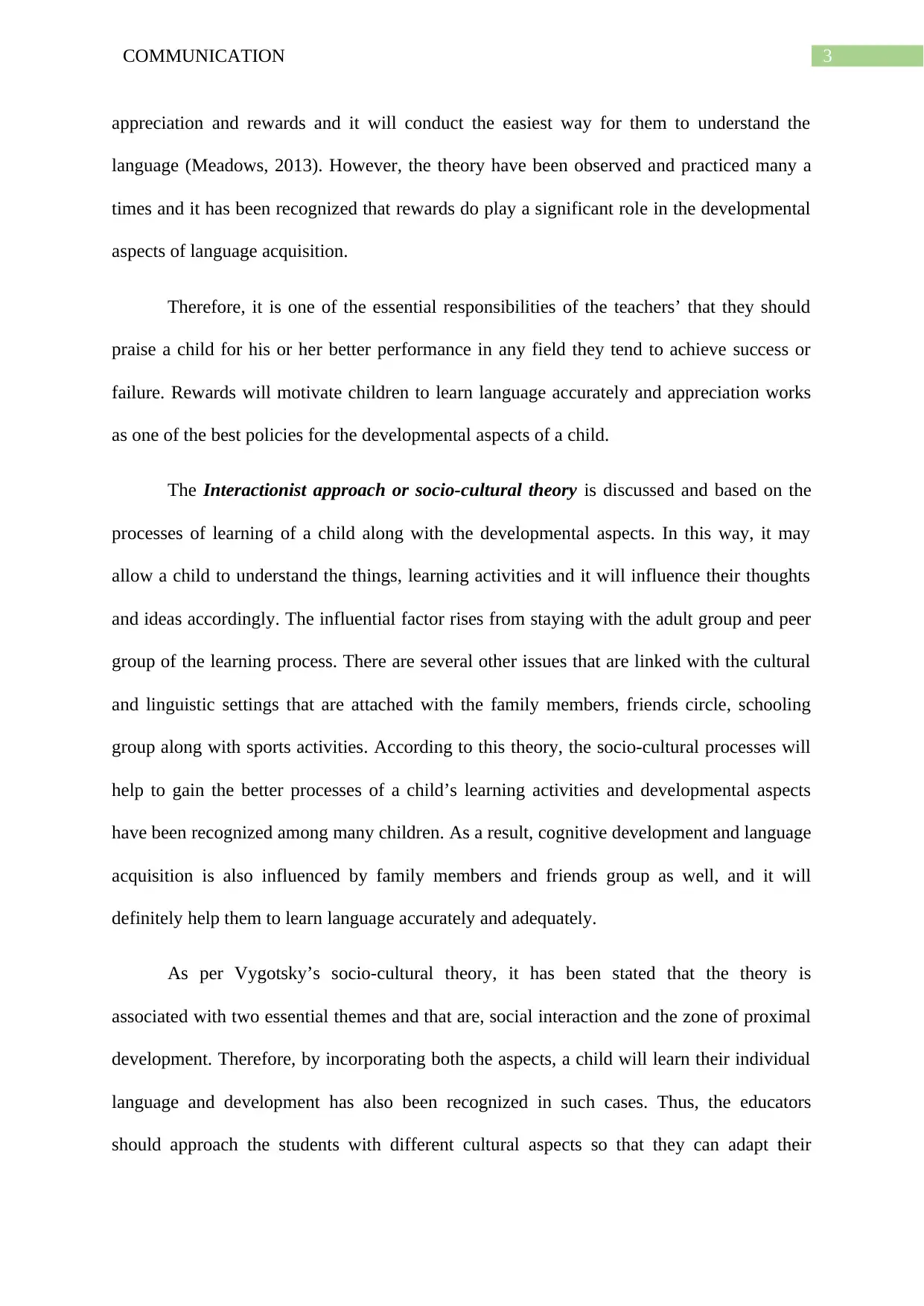
3COMMUNICATION
appreciation and rewards and it will conduct the easiest way for them to understand the
language (Meadows, 2013). However, the theory have been observed and practiced many a
times and it has been recognized that rewards do play a significant role in the developmental
aspects of language acquisition.
Therefore, it is one of the essential responsibilities of the teachers’ that they should
praise a child for his or her better performance in any field they tend to achieve success or
failure. Rewards will motivate children to learn language accurately and appreciation works
as one of the best policies for the developmental aspects of a child.
The Interactionist approach or socio-cultural theory is discussed and based on the
processes of learning of a child along with the developmental aspects. In this way, it may
allow a child to understand the things, learning activities and it will influence their thoughts
and ideas accordingly. The influential factor rises from staying with the adult group and peer
group of the learning process. There are several other issues that are linked with the cultural
and linguistic settings that are attached with the family members, friends circle, schooling
group along with sports activities. According to this theory, the socio-cultural processes will
help to gain the better processes of a child’s learning activities and developmental aspects
have been recognized among many children. As a result, cognitive development and language
acquisition is also influenced by family members and friends group as well, and it will
definitely help them to learn language accurately and adequately.
As per Vygotsky’s socio-cultural theory, it has been stated that the theory is
associated with two essential themes and that are, social interaction and the zone of proximal
development. Therefore, by incorporating both the aspects, a child will learn their individual
language and development has also been recognized in such cases. Thus, the educators
should approach the students with different cultural aspects so that they can adapt their
appreciation and rewards and it will conduct the easiest way for them to understand the
language (Meadows, 2013). However, the theory have been observed and practiced many a
times and it has been recognized that rewards do play a significant role in the developmental
aspects of language acquisition.
Therefore, it is one of the essential responsibilities of the teachers’ that they should
praise a child for his or her better performance in any field they tend to achieve success or
failure. Rewards will motivate children to learn language accurately and appreciation works
as one of the best policies for the developmental aspects of a child.
The Interactionist approach or socio-cultural theory is discussed and based on the
processes of learning of a child along with the developmental aspects. In this way, it may
allow a child to understand the things, learning activities and it will influence their thoughts
and ideas accordingly. The influential factor rises from staying with the adult group and peer
group of the learning process. There are several other issues that are linked with the cultural
and linguistic settings that are attached with the family members, friends circle, schooling
group along with sports activities. According to this theory, the socio-cultural processes will
help to gain the better processes of a child’s learning activities and developmental aspects
have been recognized among many children. As a result, cognitive development and language
acquisition is also influenced by family members and friends group as well, and it will
definitely help them to learn language accurately and adequately.
As per Vygotsky’s socio-cultural theory, it has been stated that the theory is
associated with two essential themes and that are, social interaction and the zone of proximal
development. Therefore, by incorporating both the aspects, a child will learn their individual
language and development has also been recognized in such cases. Thus, the educators
should approach the students with different cultural aspects so that they can adapt their
Secure Best Marks with AI Grader
Need help grading? Try our AI Grader for instant feedback on your assignments.
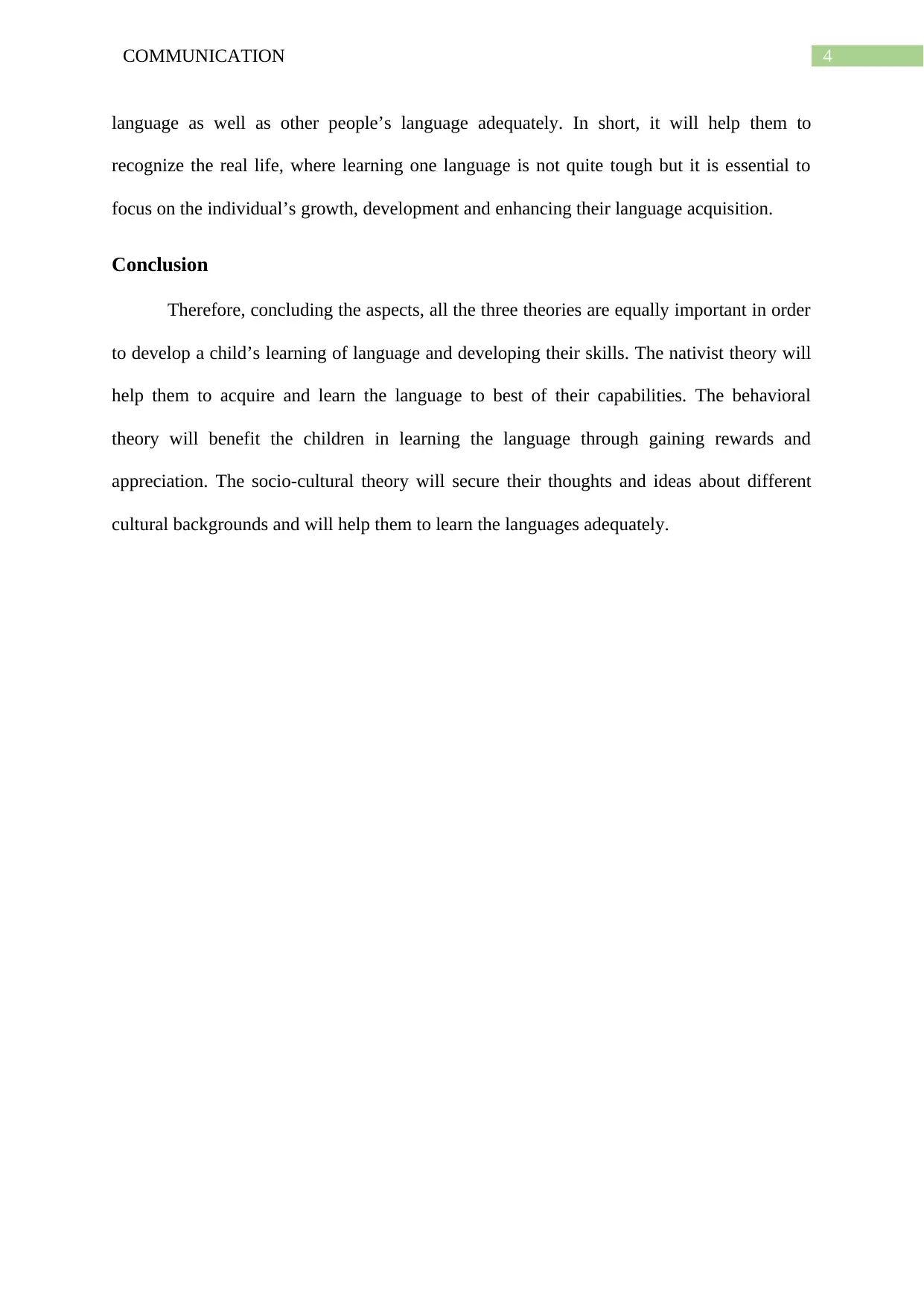
4COMMUNICATION
language as well as other people’s language adequately. In short, it will help them to
recognize the real life, where learning one language is not quite tough but it is essential to
focus on the individual’s growth, development and enhancing their language acquisition.
Conclusion
Therefore, concluding the aspects, all the three theories are equally important in order
to develop a child’s learning of language and developing their skills. The nativist theory will
help them to acquire and learn the language to best of their capabilities. The behavioral
theory will benefit the children in learning the language through gaining rewards and
appreciation. The socio-cultural theory will secure their thoughts and ideas about different
cultural backgrounds and will help them to learn the languages adequately.
language as well as other people’s language adequately. In short, it will help them to
recognize the real life, where learning one language is not quite tough but it is essential to
focus on the individual’s growth, development and enhancing their language acquisition.
Conclusion
Therefore, concluding the aspects, all the three theories are equally important in order
to develop a child’s learning of language and developing their skills. The nativist theory will
help them to acquire and learn the language to best of their capabilities. The behavioral
theory will benefit the children in learning the language through gaining rewards and
appreciation. The socio-cultural theory will secure their thoughts and ideas about different
cultural backgrounds and will help them to learn the languages adequately.
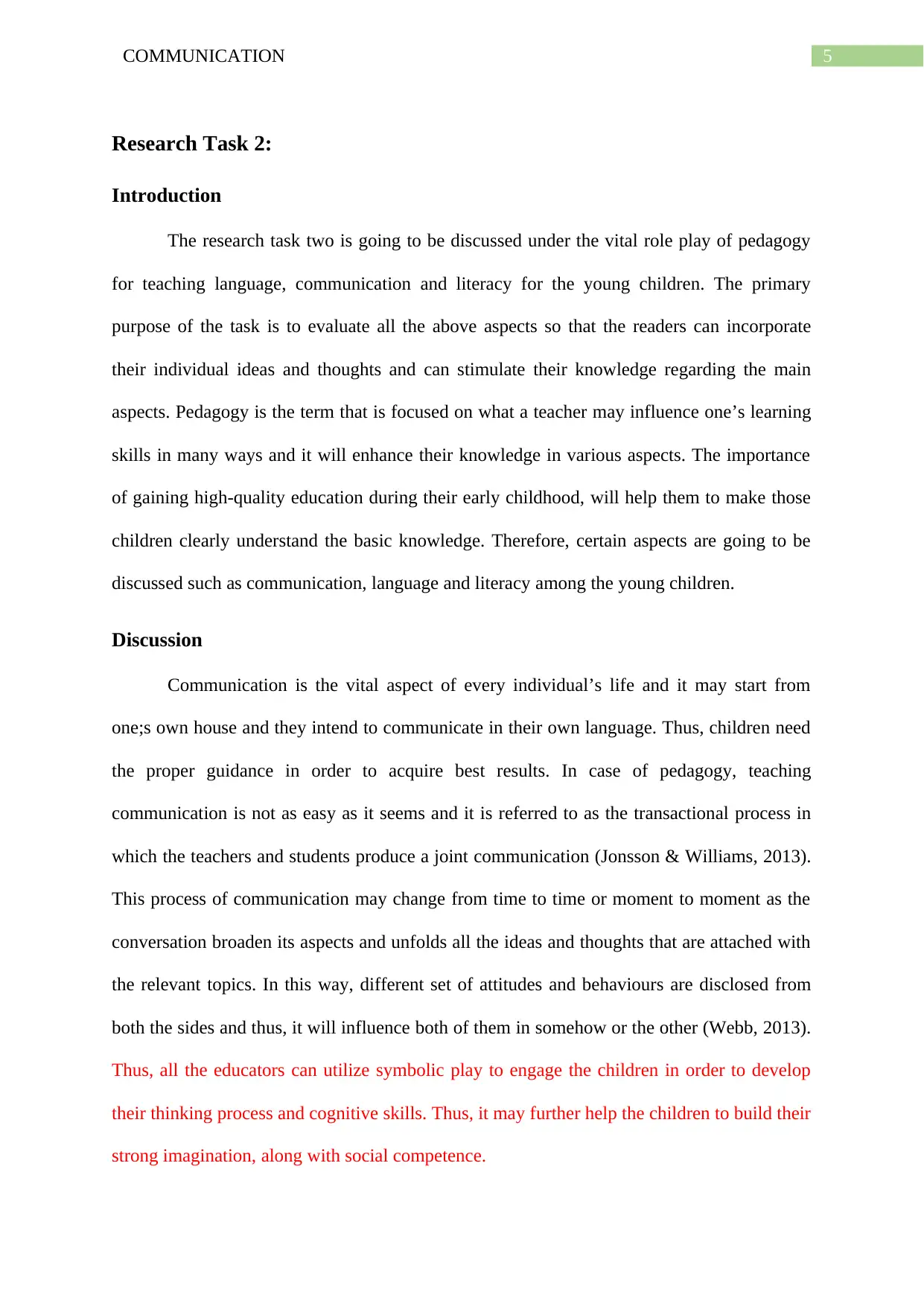
5COMMUNICATION
Research Task 2:
Introduction
The research task two is going to be discussed under the vital role play of pedagogy
for teaching language, communication and literacy for the young children. The primary
purpose of the task is to evaluate all the above aspects so that the readers can incorporate
their individual ideas and thoughts and can stimulate their knowledge regarding the main
aspects. Pedagogy is the term that is focused on what a teacher may influence one’s learning
skills in many ways and it will enhance their knowledge in various aspects. The importance
of gaining high-quality education during their early childhood, will help them to make those
children clearly understand the basic knowledge. Therefore, certain aspects are going to be
discussed such as communication, language and literacy among the young children.
Discussion
Communication is the vital aspect of every individual’s life and it may start from
one;s own house and they intend to communicate in their own language. Thus, children need
the proper guidance in order to acquire best results. In case of pedagogy, teaching
communication is not as easy as it seems and it is referred to as the transactional process in
which the teachers and students produce a joint communication (Jonsson & Williams, 2013).
This process of communication may change from time to time or moment to moment as the
conversation broaden its aspects and unfolds all the ideas and thoughts that are attached with
the relevant topics. In this way, different set of attitudes and behaviours are disclosed from
both the sides and thus, it will influence both of them in somehow or the other (Webb, 2013).
Thus, all the educators can utilize symbolic play to engage the children in order to develop
their thinking process and cognitive skills. Thus, it may further help the children to build their
strong imagination, along with social competence.
Research Task 2:
Introduction
The research task two is going to be discussed under the vital role play of pedagogy
for teaching language, communication and literacy for the young children. The primary
purpose of the task is to evaluate all the above aspects so that the readers can incorporate
their individual ideas and thoughts and can stimulate their knowledge regarding the main
aspects. Pedagogy is the term that is focused on what a teacher may influence one’s learning
skills in many ways and it will enhance their knowledge in various aspects. The importance
of gaining high-quality education during their early childhood, will help them to make those
children clearly understand the basic knowledge. Therefore, certain aspects are going to be
discussed such as communication, language and literacy among the young children.
Discussion
Communication is the vital aspect of every individual’s life and it may start from
one;s own house and they intend to communicate in their own language. Thus, children need
the proper guidance in order to acquire best results. In case of pedagogy, teaching
communication is not as easy as it seems and it is referred to as the transactional process in
which the teachers and students produce a joint communication (Jonsson & Williams, 2013).
This process of communication may change from time to time or moment to moment as the
conversation broaden its aspects and unfolds all the ideas and thoughts that are attached with
the relevant topics. In this way, different set of attitudes and behaviours are disclosed from
both the sides and thus, it will influence both of them in somehow or the other (Webb, 2013).
Thus, all the educators can utilize symbolic play to engage the children in order to develop
their thinking process and cognitive skills. Thus, it may further help the children to build their
strong imagination, along with social competence.
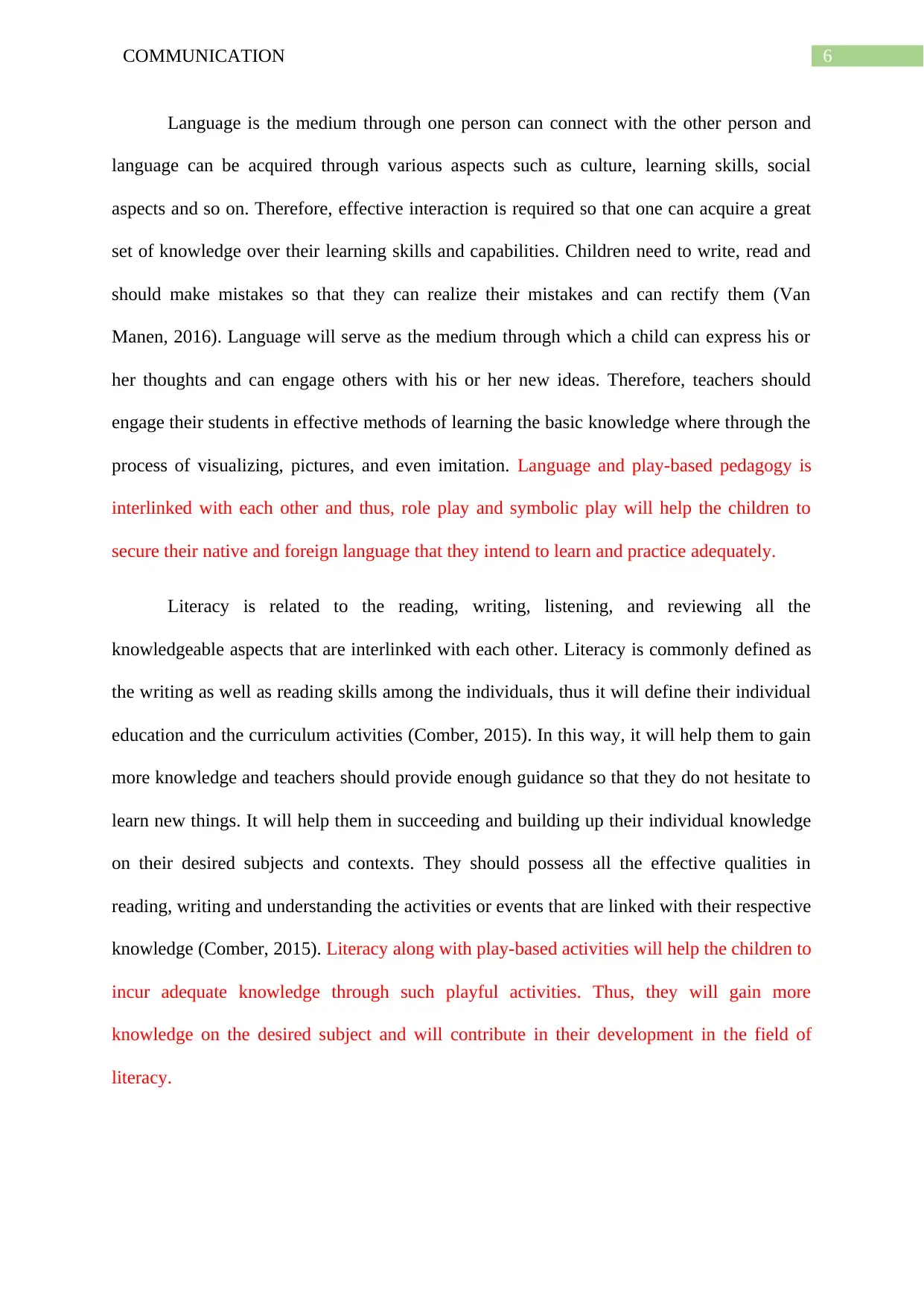
6COMMUNICATION
Language is the medium through one person can connect with the other person and
language can be acquired through various aspects such as culture, learning skills, social
aspects and so on. Therefore, effective interaction is required so that one can acquire a great
set of knowledge over their learning skills and capabilities. Children need to write, read and
should make mistakes so that they can realize their mistakes and can rectify them (Van
Manen, 2016). Language will serve as the medium through which a child can express his or
her thoughts and can engage others with his or her new ideas. Therefore, teachers should
engage their students in effective methods of learning the basic knowledge where through the
process of visualizing, pictures, and even imitation. Language and play-based pedagogy is
interlinked with each other and thus, role play and symbolic play will help the children to
secure their native and foreign language that they intend to learn and practice adequately.
Literacy is related to the reading, writing, listening, and reviewing all the
knowledgeable aspects that are interlinked with each other. Literacy is commonly defined as
the writing as well as reading skills among the individuals, thus it will define their individual
education and the curriculum activities (Comber, 2015). In this way, it will help them to gain
more knowledge and teachers should provide enough guidance so that they do not hesitate to
learn new things. It will help them in succeeding and building up their individual knowledge
on their desired subjects and contexts. They should possess all the effective qualities in
reading, writing and understanding the activities or events that are linked with their respective
knowledge (Comber, 2015). Literacy along with play-based activities will help the children to
incur adequate knowledge through such playful activities. Thus, they will gain more
knowledge on the desired subject and will contribute in their development in the field of
literacy.
Language is the medium through one person can connect with the other person and
language can be acquired through various aspects such as culture, learning skills, social
aspects and so on. Therefore, effective interaction is required so that one can acquire a great
set of knowledge over their learning skills and capabilities. Children need to write, read and
should make mistakes so that they can realize their mistakes and can rectify them (Van
Manen, 2016). Language will serve as the medium through which a child can express his or
her thoughts and can engage others with his or her new ideas. Therefore, teachers should
engage their students in effective methods of learning the basic knowledge where through the
process of visualizing, pictures, and even imitation. Language and play-based pedagogy is
interlinked with each other and thus, role play and symbolic play will help the children to
secure their native and foreign language that they intend to learn and practice adequately.
Literacy is related to the reading, writing, listening, and reviewing all the
knowledgeable aspects that are interlinked with each other. Literacy is commonly defined as
the writing as well as reading skills among the individuals, thus it will define their individual
education and the curriculum activities (Comber, 2015). In this way, it will help them to gain
more knowledge and teachers should provide enough guidance so that they do not hesitate to
learn new things. It will help them in succeeding and building up their individual knowledge
on their desired subjects and contexts. They should possess all the effective qualities in
reading, writing and understanding the activities or events that are linked with their respective
knowledge (Comber, 2015). Literacy along with play-based activities will help the children to
incur adequate knowledge through such playful activities. Thus, they will gain more
knowledge on the desired subject and will contribute in their development in the field of
literacy.
Paraphrase This Document
Need a fresh take? Get an instant paraphrase of this document with our AI Paraphraser
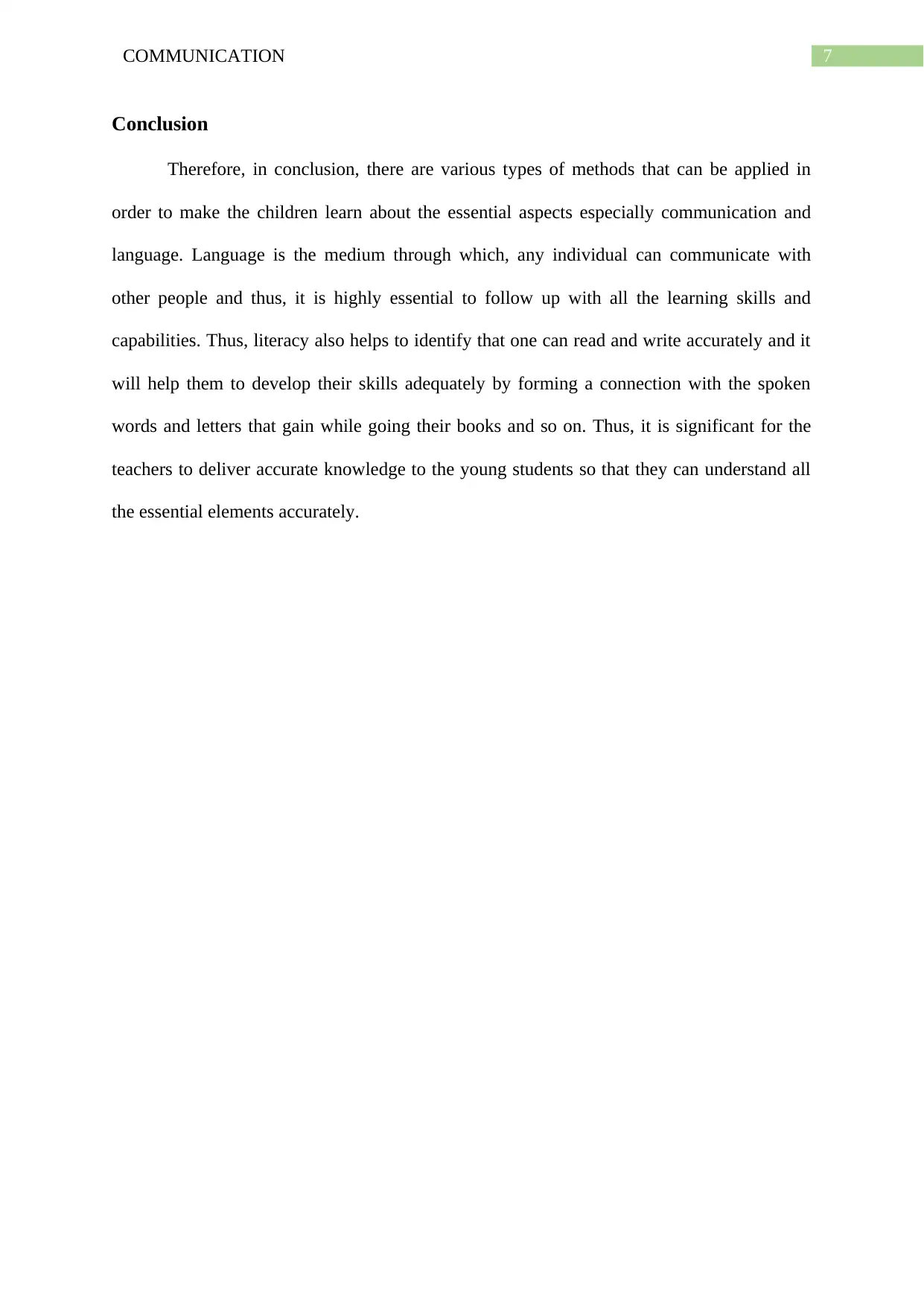
7COMMUNICATION
Conclusion
Therefore, in conclusion, there are various types of methods that can be applied in
order to make the children learn about the essential aspects especially communication and
language. Language is the medium through which, any individual can communicate with
other people and thus, it is highly essential to follow up with all the learning skills and
capabilities. Thus, literacy also helps to identify that one can read and write accurately and it
will help them to develop their skills adequately by forming a connection with the spoken
words and letters that gain while going their books and so on. Thus, it is significant for the
teachers to deliver accurate knowledge to the young students so that they can understand all
the essential elements accurately.
Conclusion
Therefore, in conclusion, there are various types of methods that can be applied in
order to make the children learn about the essential aspects especially communication and
language. Language is the medium through which, any individual can communicate with
other people and thus, it is highly essential to follow up with all the learning skills and
capabilities. Thus, literacy also helps to identify that one can read and write accurately and it
will help them to develop their skills adequately by forming a connection with the spoken
words and letters that gain while going their books and so on. Thus, it is significant for the
teachers to deliver accurate knowledge to the young students so that they can understand all
the essential elements accurately.
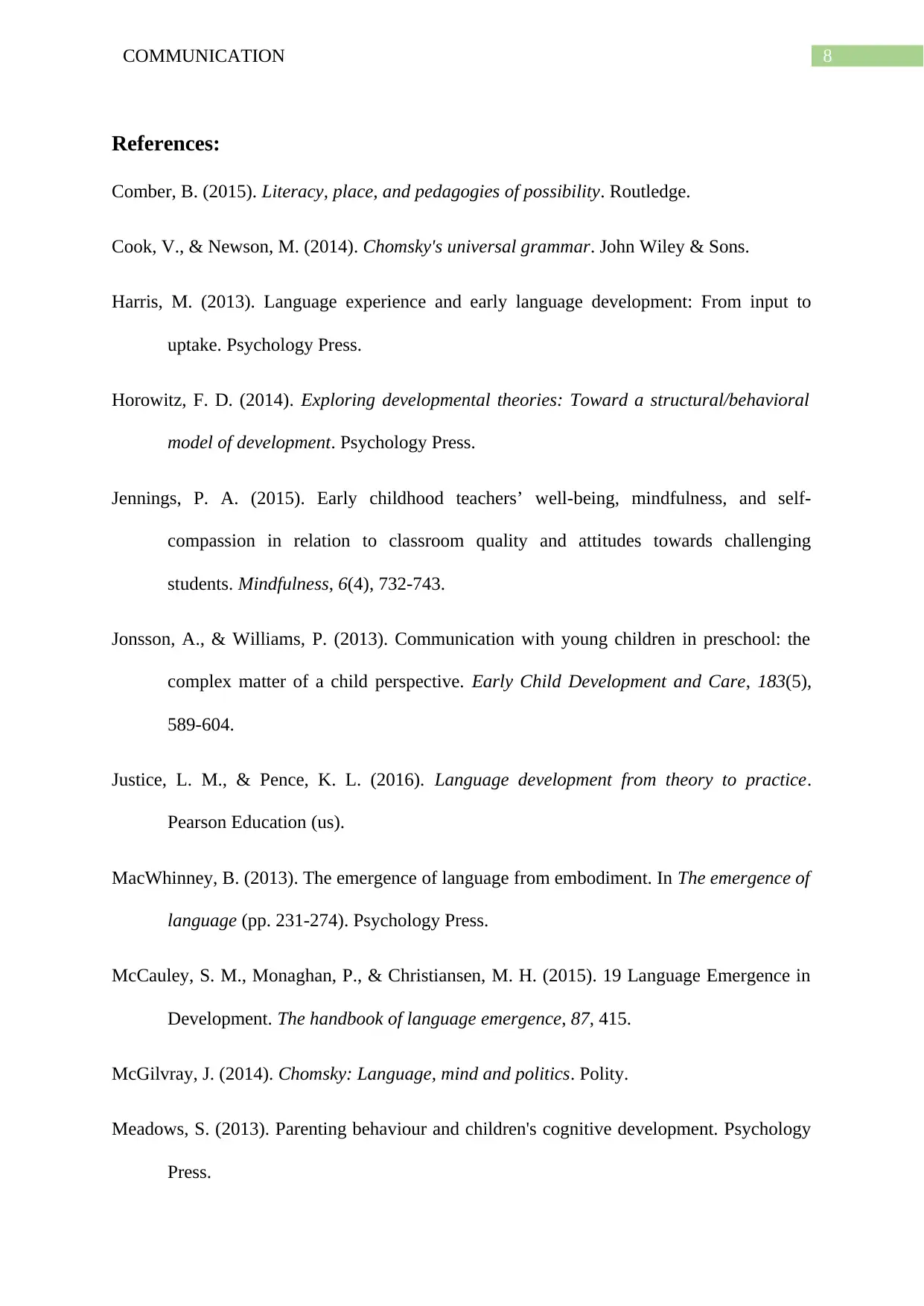
8COMMUNICATION
References:
Comber, B. (2015). Literacy, place, and pedagogies of possibility. Routledge.
Cook, V., & Newson, M. (2014). Chomsky's universal grammar. John Wiley & Sons.
Harris, M. (2013). Language experience and early language development: From input to
uptake. Psychology Press.
Horowitz, F. D. (2014). Exploring developmental theories: Toward a structural/behavioral
model of development. Psychology Press.
Jennings, P. A. (2015). Early childhood teachers’ well-being, mindfulness, and self-
compassion in relation to classroom quality and attitudes towards challenging
students. Mindfulness, 6(4), 732-743.
Jonsson, A., & Williams, P. (2013). Communication with young children in preschool: the
complex matter of a child perspective. Early Child Development and Care, 183(5),
589-604.
Justice, L. M., & Pence, K. L. (2016). Language development from theory to practice.
Pearson Education (us).
MacWhinney, B. (2013). The emergence of language from embodiment. In The emergence of
language (pp. 231-274). Psychology Press.
McCauley, S. M., Monaghan, P., & Christiansen, M. H. (2015). 19 Language Emergence in
Development. The handbook of language emergence, 87, 415.
McGilvray, J. (2014). Chomsky: Language, mind and politics. Polity.
Meadows, S. (2013). Parenting behaviour and children's cognitive development. Psychology
Press.
References:
Comber, B. (2015). Literacy, place, and pedagogies of possibility. Routledge.
Cook, V., & Newson, M. (2014). Chomsky's universal grammar. John Wiley & Sons.
Harris, M. (2013). Language experience and early language development: From input to
uptake. Psychology Press.
Horowitz, F. D. (2014). Exploring developmental theories: Toward a structural/behavioral
model of development. Psychology Press.
Jennings, P. A. (2015). Early childhood teachers’ well-being, mindfulness, and self-
compassion in relation to classroom quality and attitudes towards challenging
students. Mindfulness, 6(4), 732-743.
Jonsson, A., & Williams, P. (2013). Communication with young children in preschool: the
complex matter of a child perspective. Early Child Development and Care, 183(5),
589-604.
Justice, L. M., & Pence, K. L. (2016). Language development from theory to practice.
Pearson Education (us).
MacWhinney, B. (2013). The emergence of language from embodiment. In The emergence of
language (pp. 231-274). Psychology Press.
McCauley, S. M., Monaghan, P., & Christiansen, M. H. (2015). 19 Language Emergence in
Development. The handbook of language emergence, 87, 415.
McGilvray, J. (2014). Chomsky: Language, mind and politics. Polity.
Meadows, S. (2013). Parenting behaviour and children's cognitive development. Psychology
Press.
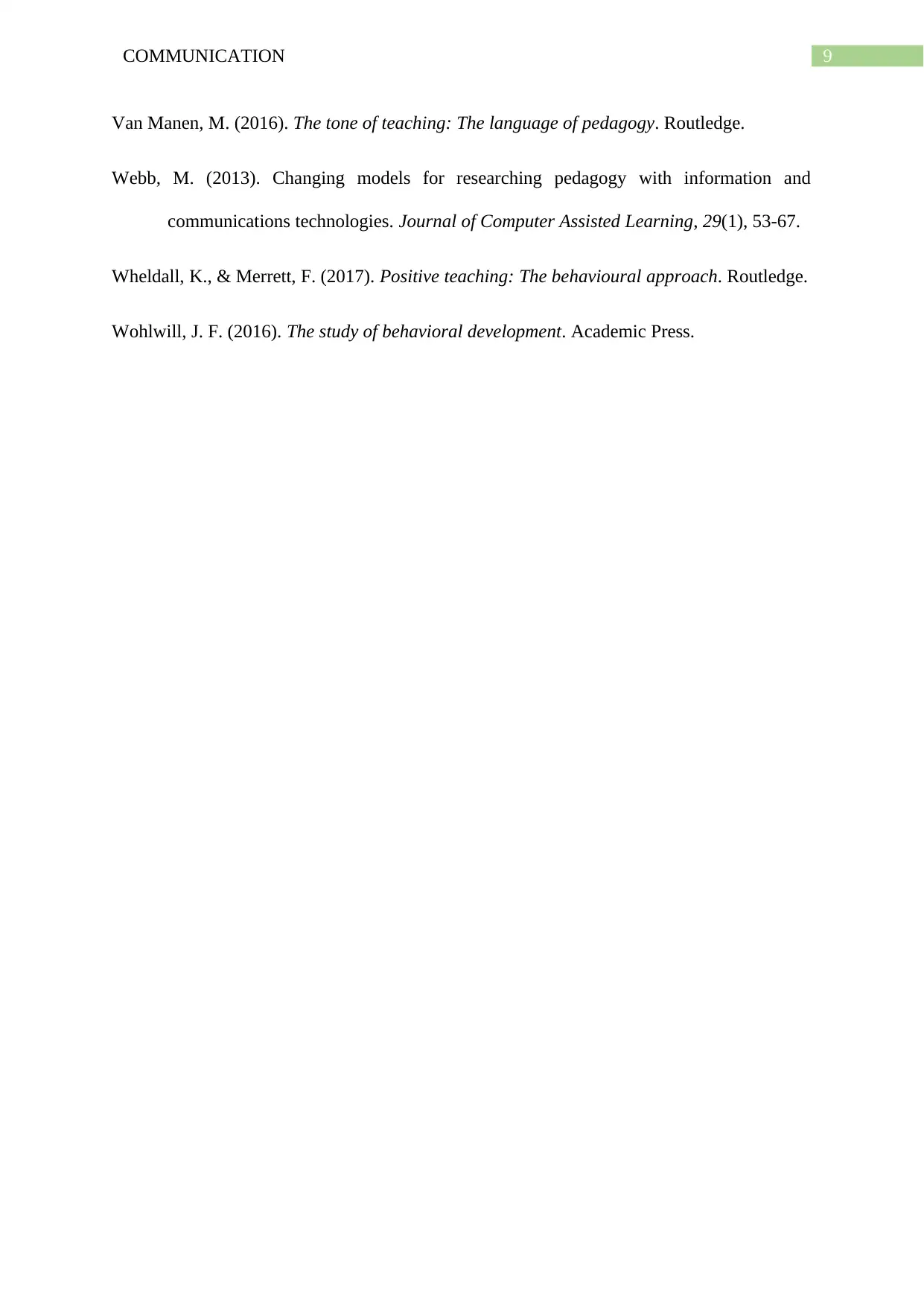
9COMMUNICATION
Van Manen, M. (2016). The tone of teaching: The language of pedagogy. Routledge.
Webb, M. (2013). Changing models for researching pedagogy with information and
communications technologies. Journal of Computer Assisted Learning, 29(1), 53-67.
Wheldall, K., & Merrett, F. (2017). Positive teaching: The behavioural approach. Routledge.
Wohlwill, J. F. (2016). The study of behavioral development. Academic Press.
Van Manen, M. (2016). The tone of teaching: The language of pedagogy. Routledge.
Webb, M. (2013). Changing models for researching pedagogy with information and
communications technologies. Journal of Computer Assisted Learning, 29(1), 53-67.
Wheldall, K., & Merrett, F. (2017). Positive teaching: The behavioural approach. Routledge.
Wohlwill, J. F. (2016). The study of behavioral development. Academic Press.
1 out of 10
Related Documents
Your All-in-One AI-Powered Toolkit for Academic Success.
+13062052269
info@desklib.com
Available 24*7 on WhatsApp / Email
![[object Object]](/_next/static/media/star-bottom.7253800d.svg)
Unlock your academic potential
© 2024 | Zucol Services PVT LTD | All rights reserved.





